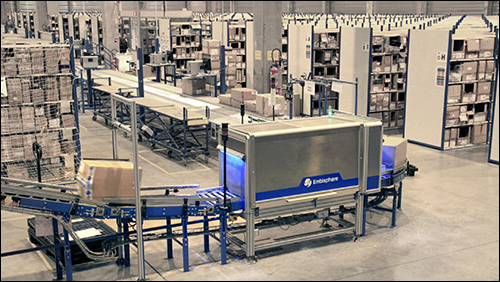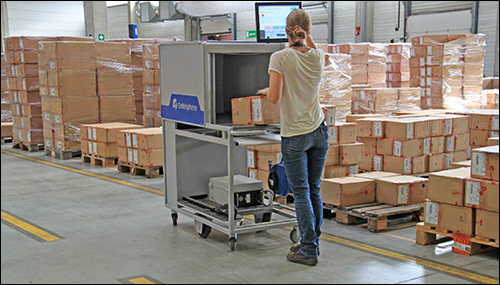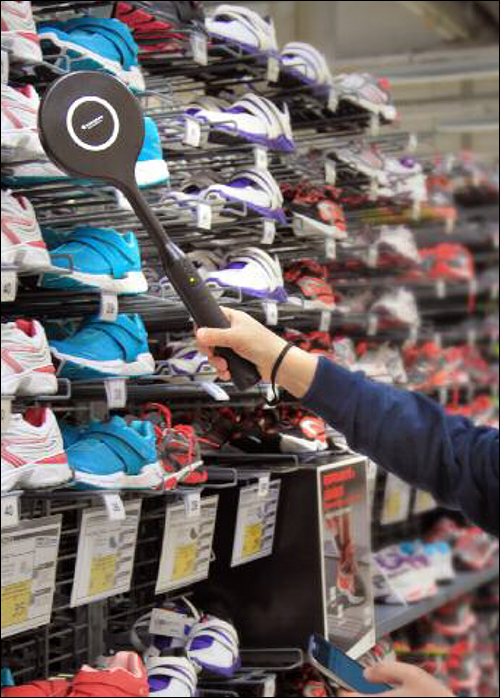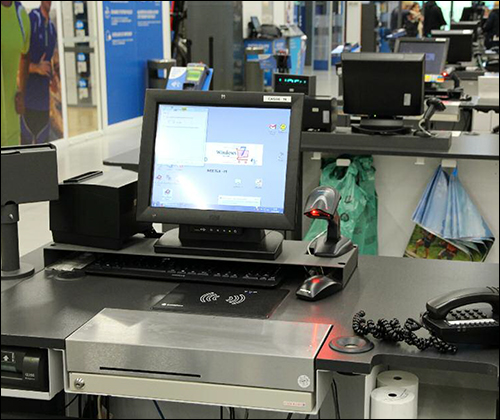In 2008, Decathlon set out to achieve three corporate goals: increase the availability of stock in its stores, boost the efficiency of its teams in retail stores and logistics areas, and improve its control of product shrinkage. The French sporting goods retailer, which opened for business in 1976, had grown from a single store in France to more than 1,000 stores in 25 countries.
The end goal was to improve customer satisfaction by ensuring items were on store shelves when customers wanted to buy them. That meant increasing inventory visibility of a wide range of merchandise. Decathlon sells roughly 35,000 different items—apparel, equipment and accessories for 65 sports, for men, women and children—usually in superstores.

In 2013, Decathlon began a global rollout of an RFID solution to track goods throughout its supply chain—from factories to warehouses to stores. Today, RFID is improving efficiencies in all Decathlon facilities—1,030 stores and 43 warehouses. The company has tagged 1.4 billion items—90 percent of its products are tagged at the point of manufacture, says Jean-Marc Lieby, who became RFID project coordinator at the beginning of 2015.
The RFID solution has increased product availability on store shelves, which, Lieby says, has had a direct impact on the customer experience and sales. “The first source of dissatisfaction of a customer is failing to find a product on the shelf,” he explains. Decathlon saw an 11 percent increase in sales from July 2014 to July 2015, and the company attributes part of that growth to the RFID deployment. Decathlon also says the RFID solution has helped the company meet its other goals: improved efficiencies and a decline in product shrinkage.
A behind-the-scenes look at how Decathlon achieved this success reveals a carefully planned and well-executed approach to addressing the retailer’s business issues.
Developing a Strategic Game Plan
In 2008, Decathlon’s managers studied possible solutions for improving internal processes and came to the realization that RFID was the only technology that could enable the retailer to meet its objectives, Lieby says. They created a project committee, led by Patrice Ribout, an IT engineer. For the next five years, they met weekly to discuss the move to RFID, with input from consulting firms. The committee examined strategies for improving processes and defined conservative key performance indicators (KPIs). They decided to examine the technology from a cost-benefit standpoint within the context of a 10-year business plan.
In 2010, Decathlon created a “lab” at a store in France, to test and measure the accuracy of various RFID handheld readers and tags. The committee also conducted a pilot at the store to evaluate several use cases.
After researching various RFID providers, Decathlon decided to create an independent company—Embisphere—to design, test and deploy its RFID system, including manufacturing the hardware and developing the software. Embisphere’s lab was also used to identify potential tag and reader suppliers. (From the beginning, Decathlon planned to offer Embisphere’s services to other retailers. Embisphere now provides RFID solutions for companies in retail, logistics, manufacturing and other sectors worldwide.)
Decathlon created a crossfunctional team, headed by Ribout, to work closely with the spin-off company. It consisted of representatives from retail, production, logistics, IT and finance. Given that the RFID project would affect processes throughout the company’s supply chain—factories, warehouses and stores—management wanted input from all major facets of the business in order to maximize RFID’s value.

From 2011 to 2013, Embisphere helped Decathlon create its RFID strategy. During that time, Decathlon conducted pilots at retail stores in 12 countries—first in Belgium, Italy and Spain, and then in China, Eastern Europe and Russia. It was important to test the different hardware and software configurations required in various countries, and to evaluate how people from different cultures would perceive and implement the RFID solution. Every six months, Decathlon’s project team met with the CEO and main sponsors of each business unit, to update them on the project’s progress.
RFID Takes the Field
In mid-2013, Decathlon launched a broad rollout of the RFID system, based on Embisphere hardware and Decathlon software. The products were developed with input from Decathlon end users in the retail and logistics departments. The system complies with EPC Gen 2 passive ultrahigh-frequency RFID standards and supports the different RFID frequencies used in North and South America, Europe and China. Embisphere supported several aspects of the project, including some systems integration, compatibility with the Decathlon software, management of encoding and tagging of products, and maintenance.
Item- and box-level tracking begins at suppliers’ factories, where manufacturers use the Embisphere and Decathlon websites to order RFID tags from approved providers, including Avery Dennison, Checkpoint Systems, Paragon Identification, SML and Tageos. Decathlon tags its own branded merchandise.
Each retail store plans its inventory requirements for a given month—roughly four weeks before the products are needed on shelves—based on historical sales, and orders goods from suppliers via an inventory-management system developed by Decathlon.
At suppliers’ factories, workers use multiple Embisphere devices to ensure the correct products are selected for shipment. One, called embiScan, is a bar-code/RFID reader connected to a PC via a USB cable, which scans items to be shipped and enters the data into the inventory-management application. EmbiScan also allows suppliers to ensure correct encoding on boxes of products and quantity of products to be shipped. “At any time during the manufacturing process, embiScan can be used for random item or box quality checks,” Lieby says.
Two other products—embiStation, a portable metal structure with four antennas, and embiWay, a fixed tunnel deployed on conveyor belts—monitor boxes as they are shipped out to Decathlon warehouses.
When boxes of products arrive at Decathlon’s warehouses from factories, embiTrolley, a mobile tunnel reader, is used for quality, inventory and shipment control. EmbiTrolley tracks the inventory, even in very densely packed boxes, within a few seconds and without the need to open the boxes. It then feeds the data into the inventory-management application, so Decathlon can track which products have arrived for shipment to the stores that need them. EmbiGates, installed near the docking area, tracks pallets into and out of the warehouses.
At stores, which typically do not have back rooms, inventory is conducted at store shelves with embiVentory, a handheld reader shaped like a badminton racket. The lightweight device has powerful antennas and is resistant to water, dust and impact, so it can read tags that are difficult to access, Lieby says. Users can insert it into a stack of densely packed products on high and low shelves to read items without much effort.
The Bluetooth-enabled reader transfers tag data to Android mobile devices, including smartphones and tablets. The devices are equipped with a Decathlon-developed app that displays the data.
EmbiPos, a stationary RFID reader, tracks product purchases at all point-of-sale locations. It sends this information to the inventory-management application so Decathlon is aware of which stores are running low on certain products. The readers are also used at product-return locations in the stores so retailers can track returns. Another version of embiPos, called embiBac, enables self-checkout by shoppers.
While most of the technology comes from Embisphere, Decathlon is using RF-enabled electronic article surveillance (EAS) gates from Checkpoint Systems and Nedap Retail at store exits.
Given the scope of Decathlon’s RFID deployment, it’s no surprise the retailer faced several challenges. From a technical standpoint, Lieby says, by far the most difficult issue was the implementation of pallet-level and conveyer tunnel readers, because they must be very fast to support the quick movement of products through warehouses to meet store demand.
In addition, these readers often operate in environments in which product containers are densely stacked in confined areas of warehouses. “We don’t require a perfect reading with these tools,” Lieby says. “What is important for us is to identify the mistakes of picking. When the products are stacked, we know the level of reading we expect and drive the quality controls on boxes [where the percentage] of reading is under the level expected.”
Decathlon also had to certify the 25,000 readers used in factories, warehouses and stores in 25 countries. Embisphere was in charge of ensuring that happened, Lieby says.
What’s more, the company had to prepare thousands of employees for new ways of performing processes, such as sales and inventory management. Decathlon used training videos and e-learning programs produced in local languages. “The goal was to have the right e-learning tools to train staff in one hour for each process,” Lieby says of the change-management program. “It took only three months to train all users worldwide.”
It’s a New Game
Decathlon is now using RFID “all over the supply chain, from factory to stores,” Lieby says. “Whether the reader reads a pallet or a box, each item included is read and the data in the central system is updated,” he says. The company aims to have 100 percent of its products tagged “as soon as possible,” he adds.
Decathlon’s early decision to test and fine-tune the technology worldwide allowed the company to RFID-enable 800 stores in just a few months, from April through July 2014. Some 60,000 employees are now using RFID on a daily basis, Lieby says. Since the beginning of 2014, Decathlon has opened more than 150 stores worldwide, all of which use the RFID system, and all new Decathlon stores going forward will be fully equipped with RFID devices, he says.
In addition to increasing product availability on store shelves, the RFID solution decreased product shrinkage by 9 percent in 2014. The retailer credits the use of the system at security gates. The shrinkage continued to decline in 2015, Lieby adds.
Other benefits include faster and easier transactions at the point of sale for shoppers, inventory cost reductions, and an increase in logistics quality and efficiency, Lieby says.
“This deployment was the biggest RFID deployment in the world,” Lieby says. “Value created by RFID has been captured in all areas of the business—from manufacturing to warehouses to stores. This deployment is the first step to realize our vision of the digital store of the future.”



